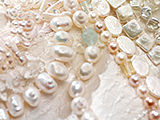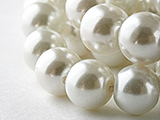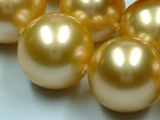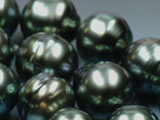Chic, classic, and cool. Pearls are best known for their precise beauty: perfectly matched spheres, poised on a silk string. But, pearls are actually incredibly diverse. They can be natural or cultured, freshwater or saltwater, nacreous or non-nacreous, and range from white to black in color, round to baroque in shape, and fitted to flowing in length.
Pearls were once made famous by Jackie Kennedy, Audrey Hepburn, and Coco Chanel. At the White House, Tiffany's window, and everywhere else, pearls were more than iconic; they were essential. And, they remain so today. In any variation, they make a sophisticated and stylish statement. As Jackie Kennedy herself confirmed, “Pearls are always appropriate.”
Pearls form inside mollusks, such as pearl oysters and mussels. When a particle becomes lodged inside a mollusk, the animal reacts by secreting a type of calcium carbonate, along with some organic material, to smooth over it. This process creates layers around the particle: an iridescent coating called nacre. Together, the particle and nacre constitute a pearl. Depending on factors such as the size of the particle and the pearl, this activity can take years to complete.
A pearl is considered “natural” when the particle nucleus occurs organically. Natural pearls are extremely rare and, therefore, prized. A “cultured” pearl is created when a pearl farmer implants the particle (usually a shell bead or piece of mantle tissue). While cultured pearls are far more common than natural, they can be incredibly beautiful in their own right.
The creation of a pearl — its growth process (natural or cultured), shape of the nucleus, mollusk type, and environment — sets the stage for its ultimate appearance and value.
Typical Natural Pearl Typical Cultured Pearl
Freshwater Pearls
Natural or cultured pearls grown in fresh water — such as lakes, ponds, and rivers, typically, in China — are called freshwater pearls. Freshwater pearls come in many appealing colors (usually pastels) and varieties, and are very durable. Though they are improving in quality, these pearls tend to be smaller and less symmetrical in shape. So, they can be very affordable.
Saltwater Pearls
Natural or cultured pearls grown in salt water — such as oceans and protected lagoons — are called saltwater pearls. The more coveted deep-colored and lustrous types of pearls typically come from salt water. The best known of these pearls are Akoya, South Sea, and Tahitian pearls.
- Akoya pearls are the most popular “classic” pearl. Traditionally farmed in Japan, today they come mainly from China. Akoyas are renowned for their luster and round shape, and are generally used in strands. They range in size from approximately three to 10 mm, and in color from white to cream, pink, or blue-grey.
- Rare and beautiful South Sea pearls come chiefly from Australia, the Philippines, and Indonesia. South Sea pearls are large — approximately 9–20 mm — and distinguished by both their fine luster and unusual hues, which range from white to silver and gold.
- Tahitian pearls, from areas in and around French Polynesia, are also quite rare and large. They are known for their nuanced range of regal, deep-colors — including dark purples, greens, and blacks — and particularly exceptional luster.
Pearls are used in a wide variety of necklaces, bracelets, pendants, rings, earrings, and brooches. Necklaces are often categorized by approximate strand length:
Collar
Choker
Princess
Matinee
Opera
Rope
12” (three or more strands)
16"
18"
22"
30–32" (usually two strands)
40” or longer (usually two or three strands, with knots)
When shopping for pearls, there are many factors to consider: quality, price, purpose, personal preference, and the simple intuition about what looks best on the intended wearer.
Of these, “quality” can be the trickiest to assess. A gemological report from a respected independent gemological laboratory, like EGL USA, can help. A professional lab report will reflect expert testing, including microscope and x-ray analyses. These studies can reveal the true caliber and potential value of the pearls, their natural versus cultured foundation, and any treatments that may have been applied to enhance their appearance.
Important quality-related pearl terms include:
Color
The main color or body color of a pearl can literally range from white to black, including the muted pastels and rich jewel tones in between. A single pearl can also reveal more than one color. For example, a pearl can have a white body color with a different overtone — a translucent secondary color, such as green or pink — on its surface. Beautiful pearls can be found in virtually any color or overtone. (Samples are shown below.) The choice is purely personal. However, other quality factors being equal, pearls of natural rare colors tend to be more expensive. In some cases, the natural color of a pearl may be enhanced through dyeing, irradiation, etc.

Luster
Luster is the reflective quality or brilliance of a pearl's surface. Luster can vary from a dull, chalky look to one of great shine. Higher luster is typically considered to be more desirable. At times, luster may be enhanced through treatments.
Matching
The visual appeal of pearl strands and jewelry depends largely on their matching: the coordination of their component pearls, in aspects like color and shape. Given the variables involved in the growth and development of pearls, matching can be challenging, particularly for those varieties of pearls that are rare to begin with. A single strand of pearls with an unusual natural hue, for example, may take years to match, and its price will reflect this.
A typical gemological report would rate matching on a scale from poor to excellent.
Measurements
Pearl sizes vary greatly, especially between different pearl types. All other quality factors being equal, larger pearls tend to be more costly, due to their scarcity. However, size is entirely a matter of taste. The size of a round pearl is its diameter, measured in millimeters. Other pearls are measured by length x width x depth. Measurements of pearl strands or jewelry are described as a range, average, or graduation from maximum to minimum.
On occasion, depending on pearl type, measurements can also be described in grams, carats (.2 gram), or grains (.065 gram).

|
3mm |
4mm |
5mm |
6mm |
7mm |
8mm |
9mm |
10mm |
Nacre
Nacre refers to the iridescent coating over a pearl's nucleus. Thicker nacre makes for a naturally more durable pearl and tends to give it a higher luster. This can increase the pearl's value, all other quality factors being equal. So, on a report, a rating of “thick” (versus “thin” or “medium,” for example) is generally preferred. The related term “nacreous pearl” refers to a pearl that appears translucent, due to its fine, plate-like crystalline layers and organic material. Gem-quality pearls are most often nacreous, as opposed to the more porcelain-looking “non-nacreous.”
Shape
Pearls can be found in a variety of forms, from round to irregular, as shown below. Shape selection is purely personal. However, other quality factors being equal, round pearls are typically the most uncommon and, therefore, costly. Unusual baroque pearls can also be sought-after for their one-of-a-kind silhouettes.
Surface
The outermost layer of a pearl will inevitably contain bumps, wrinkles, minor cracks, and/or chips which will, in turn, impact its visual appeal. Simply put, the smoother the surface, the better.
Note: All photos and diagrams above are intended as general guides.
Renderings may vary with computer settings.
Exceptional scope and/or splendor can create particularly distinct pearls.
La Peregrina — perhaps, the most famous natural pearl in the world — is renowned for its combination of size and beauty. The pear-shaped, 50-carat stone was discovered in the late 16th century, and has been owned by kings, royals, and Elizabeth Taylor. It was sold as part of a necklace in December 2011, for almost $12 million.
The Hope Pearl is a striking, but irregularly shaped 450-carat pearl. It features unique coloring, ranging from white to dark bronze, and is capped by a colorful crown-shaped pendant.
The far less beautiful, but largest known pearl is the Pearl of Lao Tzu (or the Pearl of Allah). This non-nacreous specimen resembles a brain, and is 14 pounds in weight and 9 inches in length. The pearl is shrouded in decades of mystery and controversy, and is rumored to be cursed.
The Palawan Princess is estimated to be one of the largest pearls in the world. The non-nacreous pearl also resembles a brain. It is five pounds in weight and six inches in length. EGL USA gemologists authenticated this specimen in 2008.
Pearls are relatively soft gemstones that need to be handled with care. Pearls like to be worn; it keeps them from dehydrating. But, be sure to put them on last and take them off first. Avoid all chemicals and cosmetics (including perfume and hair spray); intense exposure to heat, light, or quick temperature changes; and any physical activities that may damage the stones.
Pearls should be gently cleaned with a soft, white cloth and stored separately, in a soft cloth or pouch, to prevent scratching. Depending on wear, pearl strands should be restrung as often as once a year. Consult a professional jeweler for additional details.











